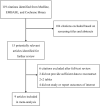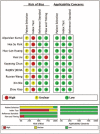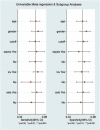Meta-analysis of procalcitonin as a predictor for acute kidney injury
- PMID: 33725877
- PMCID: PMC7969283
- DOI: 10.1097/MD.0000000000024999
Meta-analysis of procalcitonin as a predictor for acute kidney injury
Abstract
Background: Procalcitonin (PCT) was used for predicting the development of acute kidney injury (AKI) in several studies recently. We aimed to investigate the accuracy of PCT for predicting AKI in this study.
Methods: Studies that assessed the predictive performance of PCT for the development of AKI in adult patients were searched from Medline, Embase, and the Cochrane Library from inception to June 2020. We calculated the pooled sensitivities and specificities and the area under the summary receiver-operating characteristic (SROC) curves. I2 was used to test the heterogeneity and the potential heterogeneity was investigated by meta-regression.
Results: In total, 9 of 119 studies with 4852 patients were included, 1272 were diagnosed with AKI. In the overall analysis, the area under the SROC curve was 0.82 (95% CI, 0.79-0.85) and the pooled sensitivity and specificity were 0.76 (95% confidence interval [CI], 0.64-0.85) and 0.75 (95% CI, 0.61-0.86), respectively. In the subgroup analysis among septic patients, the pooled sensitivity and specificity were 0.59 (95% CI, 0.29-0.84) and 0.53 (95% CI, 0.31-0.74), and the area under the SROC was 0.57 (95% CI, 0.53-0.62).
Conclusion: PCT may be a potential predictor for the development of AKI.
Copyright © 2021 the Author(s). Published by Wolters Kluwer Health, Inc.
Conflict of interest statement
The authors have no conflicts of interests to disclose.
Figures








Similar articles
-
A risk score based on procalcitonin for predicting acute kidney injury in COVID-19 patients.J Clin Lab Anal. 2021 Jun;35(6):e23805. doi: 10.1002/jcla.23805. Epub 2021 May 25. J Clin Lab Anal. 2021. PMID: 34032326 Free PMC article.
-
Procalcitonin and N-Terminal Pro-B-Type Natriuretic Peptide for Prognosis in Septic Acute Kidney Injury Patients Receiving Renal Replacement Therapy.Blood Purif. 2019;48(3):262-271. doi: 10.1159/000501388. Epub 2019 Jul 16. Blood Purif. 2019. PMID: 31311006
-
Serum procalcitonin levels predict acute kidney injury in critically ill patients.Nephrology (Carlton). 2018 Dec;23(12):1090-1095. doi: 10.1111/nep.13174. Nephrology (Carlton). 2018. PMID: 28967168
-
Diagnosis and prognosis of neutrophil gelatinase-associated lipocalin for acute kidney injury with sepsis: a systematic review and meta-analysis.Crit Care. 2016 Feb 16;20:41. doi: 10.1186/s13054-016-1212-x. Crit Care. 2016. PMID: 26880194 Free PMC article.
-
Diagnostic value of neutrophil gelatinase-associated lipocalin for early diagnosis of cardiac surgery-associated acute kidney injury: a meta-analysis.Eur J Cardiothorac Surg. 2016 Mar;49(3):746-55. doi: 10.1093/ejcts/ezv199. Epub 2015 Jun 20. Eur J Cardiothorac Surg. 2016. PMID: 26094017 Review.
Cited by
-
Procalcitonin: Infection or Maybe Something More? Noninfectious Causes of Increased Serum Procalcitonin Concentration: Updated Knowledge.Life (Basel). 2025 Mar 12;15(3):446. doi: 10.3390/life15030446. Life (Basel). 2025. PMID: 40141790 Free PMC article. Review.
-
Predictive Ability of Procalcitonin for Acute Kidney Injury: A Narrative Review Focusing on the Interference of Infection.Int J Mol Sci. 2021 Jun 27;22(13):6903. doi: 10.3390/ijms22136903. Int J Mol Sci. 2021. PMID: 34199069 Free PMC article. Review.
-
The diagnostic value of next-generation sequencing technology in sepsis.Front Cell Infect Microbiol. 2022 Sep 14;12:899508. doi: 10.3389/fcimb.2022.899508. eCollection 2022. Front Cell Infect Microbiol. 2022. PMID: 36189371 Free PMC article.
-
Procalcitonin and High APACHE (Acute Physiological and Chronic Health Evaluation) Level Are Associated with the Course of Acute Kidney Injury in Patients with SARS-CoV-2.Int J Clin Pract. 2022 Oct 7;2022:1363994. doi: 10.1155/2022/1363994. eCollection 2022. Int J Clin Pract. 2022. PMID: 36277469 Free PMC article.
-
Machine learning-based model to predict severe acute kidney injury after total aortic arch replacement for acute type A aortic dissection.Heliyon. 2024 Jul 5;10(13):e34171. doi: 10.1016/j.heliyon.2024.e34171. eCollection 2024 Jul 15. Heliyon. 2024. PMID: 39071670 Free PMC article.
References
-
- Wald R, Quinn RR, Luo J, et al. . Chronic dialysis and death among survivors of acute kidney injury requiring dialysis. JAMA 2009;302:1179–85. - PubMed
-
- See EJ, Jayasinghe K, Glassford N, et al. . Long-term risk of adverse outcomes after acute kidney injury: a systematic review and meta-analysis of cohort studies using consensus definitions of exposure. Kidney Int 2019;95:160–72. - PubMed
-
- Ronco C, Bellomo R, Kellum JA. Acute kidney injury. Lancet (London, England) 2019;394:1949–64. - PubMed
Publication types
MeSH terms
Substances
Grants and funding
LinkOut - more resources
Full Text Sources
Other Literature Sources

